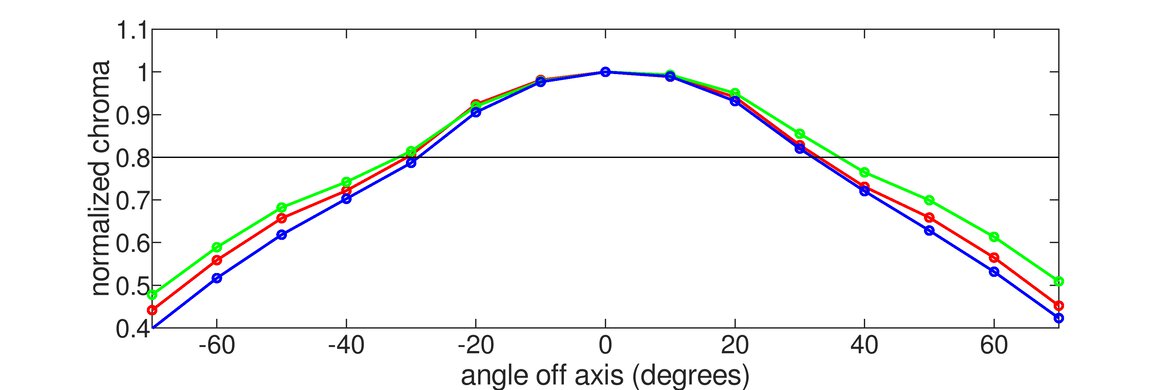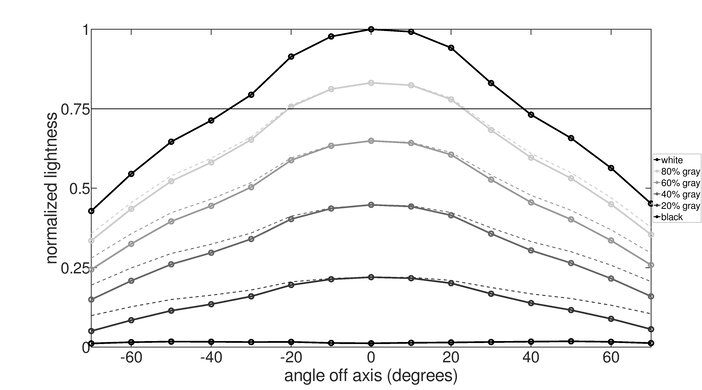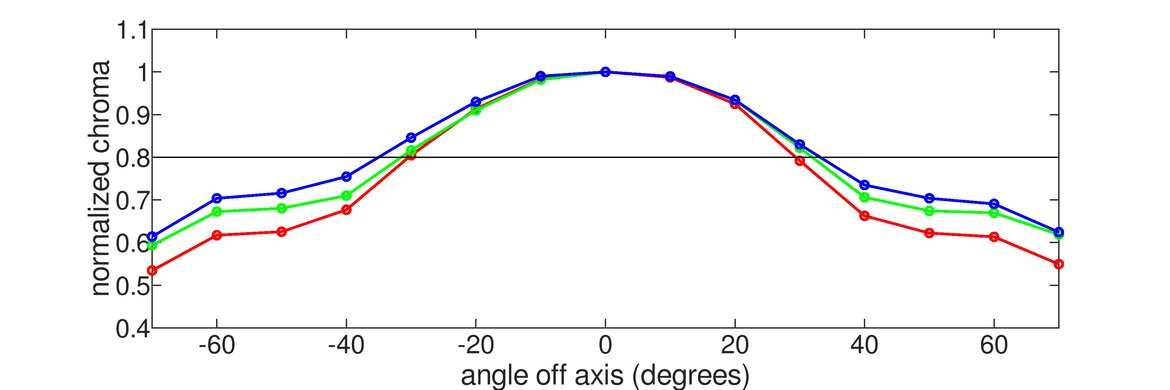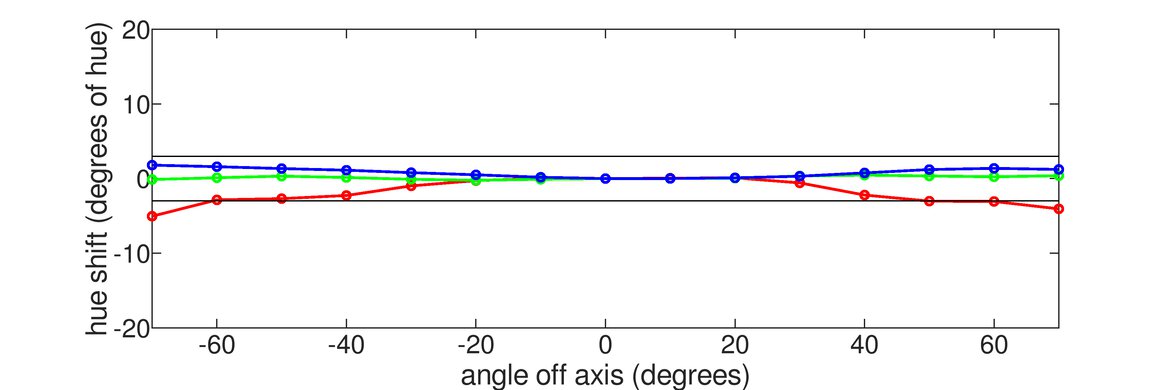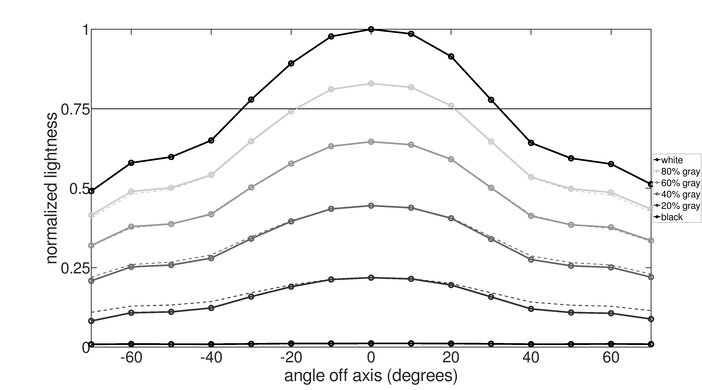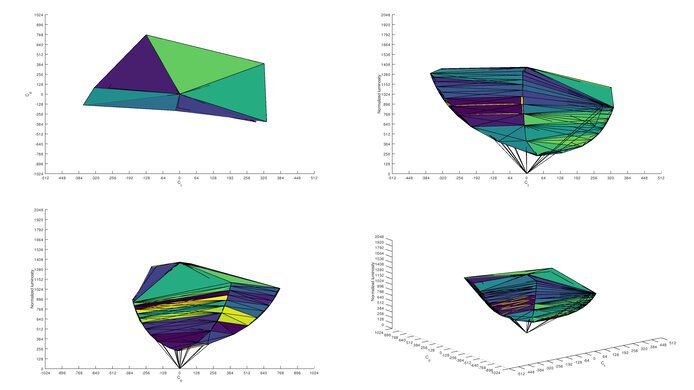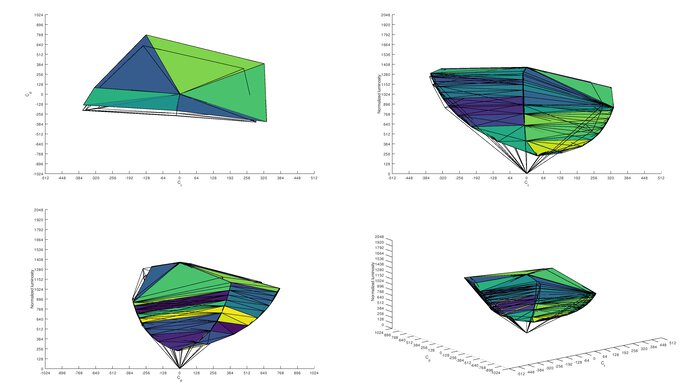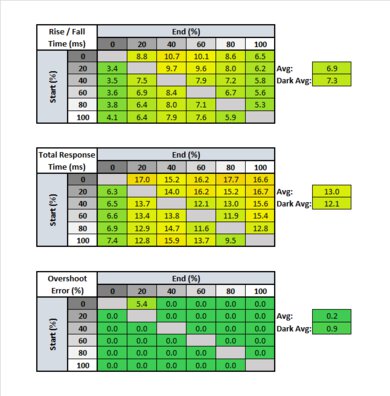The ASUS ROG Strix XG27UQ is an excellent 4k gaming monitor. Its large 27 inch screen displays razor-sharp images and text, and it has good ergonomics and decent viewing angles, making it suitable for a wide range of uses. It has a fast response time, low input lag, and a 144Hz refresh rate, resulting in smooth motion and incredible responsiveness. However, it requires a graphics card with Display Stream Compression and a DisplayPort connection to achieve such a high refresh rate since it lacks an HDMI 2.1 port. It supports Adaptive Sync and is compatible with FreeSync and G-SYNC. Its IPS panel has decent reflection handling and gets bright enough to combat intense glare. It isn't as well-suited for dark rooms, though, as its low contrast ratio makes blacks look grayish. It has a good wide color gamut and gets decently bright in HDR, but the local dimming is terrible and can be quite distracting.
Our Verdict
The ASUS ROG Strix XG27UQ is a great monitor overall. It has a large 4k screen that makes it suitable for work, gaming, or media consumption. Gaming feels responsive due to its low input lag and high refresh rate, and it has a fast response time and a Black Frame Insertion feature to deliver clear images. It has an outstanding SDR color gamut for viewing and creating content, but the contrast ratio is low, resulting in blacks that look gray in the dark.
- Large screen and 4k resolution.
- Good visibility in bright rooms.
- Good ergonomics.
- Mediocre contrast ratio.
- Images look washed out when viewed from the side.
The ASUS ROG Strix XG27UQ is great for office use. It has a large screen for multitasking, and its high pixel density results in outstanding text clarity. Its decent viewing angles make it easier to share your work with colleagues, but the image looks a bit washed out from the side and might not be ideal if image accuracy is a must. Luckily, it has good ergonomics. It handles reflections decently well and gets more than bright enough to overcome glare.
- Large screen and 4k resolution.
- Good visibility in bright rooms.
- Good ergonomics.
- Mediocre contrast ratio.
- Images look washed out when viewed from the side.
The ASUS ROG Strix XG27UQ is an excellent gaming monitor. It has a low input lag, fast response time, and a 144Hz refresh rate, resulting in smooth and responsive gameplay. It has a Black Frame Insertion feature to improve motion clarity, which you can use simultaneously with variable refresh rate. Its large high-resolution screen provides incredible immersion, making it a great choice for playing atmospheric games like RPGs. Sadly, it isn't the best option for gaming in the dark due to its low contrast and mediocre black uniformity.
- Large screen and 4k resolution.
- 144Hz refresh rate.
- Outstanding response time.
- Good ergonomics.
- Mediocre contrast ratio.
- Requires graphics card with DSC for 144Hz.
The ASUS ROG Strix XG27UQ is great for media consumption. It has a large high-resolution screen that delivers stunning picture quality. It allows for a good amount of ergonomic adjustments so that you can place the screen at your optimal viewing position, and its decent viewing angles make it easier to share content with others. It isn't the best option for dark room viewing as its low contrast ratio makes blacks look gray.
- Large screen and 4k resolution.
- Good visibility in bright rooms.
- Good ergonomics.
- Outstanding SDR color gamut.
- Mediocre contrast ratio.
- Images look washed out when viewed from the side.
The ASUS ROG Strix XG27UQ is great for media creation. It has a large 4k screen that allows you to see all the fine details in your work with amazing clarity. It has an outstanding SDR color gamut with full sRGB coverage, making it suitable for color work. Unfortunately, it doesn't display dark colors well due to its low contrast ratio, and even though it has decent viewing angles, images look washed out from the side.
- Large screen and 4k resolution.
- Good visibility in bright rooms.
- Good ergonomics.
- Outstanding SDR color gamut.
- Mediocre contrast ratio.
- Images look washed out when viewed from the side.
The ASUS ROG Strix XG27UQ is good for gaming in HDR. It provides a smooth and responsive gaming experience thanks to its low input lag, fast response time, and high refresh rate. It has a good HDR color gamut and decent peak brightness, but its low contrast ratio makes blacks look gray, and the local dimming feature is terrible.
- Large screen and 4k resolution.
- 144Hz refresh rate.
- Outstanding response time.
- Good ergonomics.
- Mediocre contrast ratio.
- Requires graphics card with DSC for 144Hz.
- Terrible local dimming.
Changelog
- Updated Jun 14, 2023: Clarified that the ASUS ROG Strix XG27UQR is an updated monitor that's similar, but isn't exactly like the XG27UQ in Variants.
- Updated Jan 18, 2022: Discovered that it doesn't have PIP/PBP software.
- Updated Dec 03, 2020: Review published.
- Updated Nov 30, 2020: Early access published.
Check Price
Differences Between Sizes And Variants
We tested the 27-inch ASUS ROG Strix XG27UQ, and it's the only size available. There's a similar monitor that's an updated version of it, the ASUS ROG Strix XG27UQR, but it performs differently, and the results don't apply.
| Model | Size | Resolution | Refresh Rate | VRR | Swivel Range |
|---|---|---|---|---|---|
| XG27UQ | 27" | 4k | 144Hz | Adaptive Sync | -40° to 40° |
| XG27UQR | 27" | 4k | 144Hz | FreeSync | -25° to 25° |
If someone comes across a different type of panel or their ASUS ROG Strix XG27UQ doesn't correspond to our review, let us know, and we'll update the review. Note that some tests, such as the gray uniformity, may vary between individual units.
Our unit was manufactured in September 2020; you can see the label here.
Popular Monitor Comparisons
The ASUS ROG XG27UQ is an excellent gaming monitor that's also well-suited for productivity and media consumption. It's one of the best high-refresh 4k monitors on the market, but it comes with a high price tag, and its 144Hz refresh rate is only achievable with a graphics card that supports Display Stream Compression. For other options, check out our recommendations for the best 4k gaming monitors, the best HDR gaming monitors, and the best 144Hz monitors.
The ASUS ROG Strix XG27UQR is an updated version of the ASUS ROG Strix XG27UQ. While they have different stands with better ergonomics on the XG27UQ, they're very similar in features and performance. The XG27UQR has the same 144Hz refresh rate with HDMI 2.0 bandwidth as the XG27UQ and has the same selection of inputs. The main advantage the XG27UQR has is its slightly improved color gamut; other than that, they're very similar monitors.
Overall, the ASUS ROG Strix XG27UQ and the LG 27GN950-B are very similar, but the LG has a slightly higher refresh rate of 160Hz. The ASUS is better a choice if you need swivel adjustments, and it has better reflection handling for gaming in a bright room. It has a Black Frame Insertion feature that the LG doesn't have, but it causes slight image duplication and may not be to everyone's liking. The LG has wider viewing angles that are more ideal for sharing content or playing co-op games, and it gets a lot brighter in HDR, although the brightness isn't as consistent. It has a faster response time as well, which results in clearer images in fast-moving scenes.
The ASUS ROG Strix XG27UQ and the Acer Nitro XV282K KVbmiipruzx are both excellent 4k gaming monitors. Even though they each have a 144Hz refresh rate, you can only reach that refresh rate over HDMI with the Acer because it has HDMI 2.1 inputs while the ASUS has HDMI 2.0. The Acer has native FreeSync support, which the ASUS doesn't, but their VRRs work with NVIDIA and AMD graphics cards. The ASUS gets much brighter in SDR, making it a better choice for well-lit rooms.
The ASUS ROG Strix XG27UQ and the Gigabyte M28U are very similar overall, but the ASUS is slightly better for most people, as it has better ergonomics. The Gigabyte has slightly better reflection handling, and its black frame insertion feature is a bit more versatile, as it works across a wider range of refresh rates.

We buy and test more than 30 monitors each year, with units that we buy completely on our own, without any cherry-picked units or samples. We put a lot into each unbiased, straight-to-the-point review, and there's a whole process from purchasing to publishing, involving multiple teams and people. We do more than just use the monitor for a week; we use specialized and custom tools to measure various aspects with objective data-based results. We also consider multiple factors before making any recommendations, including the monitor's cost, its performance against the competition, and whether or not it's easy to find.
Test Results

The ASUS ROG Strix XG27UQ's design is almost identical to the ASUS ROG Strix XG279Q but with thick borders on all four sides. It has a tripod-style stand with an LED light that shines onto the desk, which you can customize with the included acrylic covers to show the ROG logo. There's a larger ROG logo on the back that also lights up. You can control the color and lighting effects of both lighting zones with ASUS' Aura Sync software.
The back looks exactly like the ASUS ROG Strix XG279Q as it has the same etchings and ROG logo. There's a small cutout at the bottom of the stand for cable management. There's no quick-release feature to remove the stand for VESA-mounting.
The ASUS XG27UQ's build quality is great. The stand's feet are metal while the column is plastic. It's very heavy and doesn't wobble. The back is also made of sturdy plastic, and the adjustment hinges are of good quality, although the plastic covering them feels a bit flimsy. There aren't any loose parts or obvious gaps in the construction, and most people shouldn't have any issues with it.
The ASUS XG27UQ has a mediocre contrast ratio, resulting in blacks that look grayish when viewed in a dark room. It's slightly higher than the advertised 1000:1; however, contrast can vary between individual units. The local dimming feature doesn't improve the black level at all, and enabling it locks the screen's brightness to max automatically.
The ASUS ROG Strix XG27UQ has a terrible local dimming feature. It's called Dynamic Dimming in the on-screen settings menu. It's edge-lit, and there are eight vertical lighting zones. Zone transition is relatively fast but not smooth, so it's very visible. However, it isn't noticeable with small objects, as it seems like it requires an object of a certain size to trigger the local dimming. There's no black crush because the black level is raised when a zone lights up. There's a lot of blooming due to the large vertical zones, but blooming around subtitles isn't really noticeable in regular content since most of the zones are on all the time. It can be distracting in dark scenes when only a few zones are lit, as the difference in contrast between the zones that are on and those that are off is very drastic.
The ASUS XG27UQ has great SDR peak brightness. It's remarkably consistent across different content, and it's more than enough to overcome glare.
We measured the SDR peak brightness after calibration in the 'User' Picture Mode, with Brightness set to max.
Decent HDR peak brightness. It's higher than the advertised 400 cd/m² and meets its DisplayHDR 400 certification requirement. It's very consistent when displaying different content, but unlike in SDR, there's a bit of dimming in the 2% window, so small highlights in dark scenes don't pop as much. It can make some highlights stand out, although it's more noticeable in a dark room than in a bright one.
We measured the HDR peak brightness in the 'ASUS Gaming HDR' Picture Mode.
Although the ASUS ROG Strix XG27UQ has an IPS panel, its horizontal viewing angles are only decent. Colors look washed out fairly early as you move off-center, followed by gamma shift. It should be fine for sharing content casually or co-op gaming, but not if you require image accuracy. If you want a monitor with wider viewing angles, check out the ASUS ROG Strix XG27AQ.
The vertical viewing angles are decent. Images look a bit washed out if you mount the monitor above eye level.
Our ASUS ROG Strix XG27UQ has excellent gray uniformity; however, this can vary between units. The sides appear darker, especially at the top corners, but there's almost no dirty screen effect. Uniformity is much better in dark scenes.
The ASUS ROG Strix XG27UQ has great accuracy out of the box. Most color inaccuracies shouldn't be visible to the naked eye, but white balance is a bit off. The color temperature is very close to our 6500k, and gamma follows the sRGB curve well, although dark and bright scenes are slightly over-brightened. Note that accuracy can vary between individual units.
The ASUS ROG Strix XG27UQ's accuracy is exceptional after calibration. White balance is much improved, and color accuracy is also slightly better. The color temperature is still within the same ballpark. Gamma hasn't changed much, except that bright scenes are brighter than before calibration.
You can download our ICC profile calibration here. This is provided for reference only and shouldn't be used, as the calibration values vary per individual unit due to manufacturing tolerances, even for the same model.
The ASUS ROG Strix XG27UQ has a good HDR color gamut. It has excellent coverage of the DCI P3 color space used in most content and decent coverage of the wider Rec. 2020.
Our measurement of the DCI P3 coverage is slightly lower than the advertised 90% coverage due to how we measure it. We measure it by sending a Rec. 2020 signal, but unlike most reviewers, we limit the colors to the DCI P3 primaries. This results in a lower but arguably more accurate measurement.
| Overdrive Setting | Response Time Chart | Response Time Tables | Motion Blur Photo |
| Level 0 | Chart | Table | Photo |
| Level 1 | Chart | Table | Photo |
| Level 2 | Chart | Table | Photo |
| Level 3 | Chart | Table | Photo |
| Level 4 | Chart | Table | Photo |
| Level 5 | Chart | Table | Photo |
The ASUS ROG Strix XG27UQ has outstanding response time at its max refresh rate, resulting in only a short blur trail behind fast-moving objects. Our recommended overdrive setting is 'Level 3' as it provides the best performance without causing too much overshoot like the 'Level 4' and 'Level 5' options. The LG 27GP850-B/27GP83B-B has a slightly faster max refresh rate, and a slightly faster response time.
| Overdrive Setting | Response Time Chart | Response Time Tables | Motion Blur Photo |
| Level 0 | Chart | Table | Photo |
| Level 1 | Chart | Table | Photo |
| Level 2 | Chart | Table | Photo |
| Level 3 | Chart | Table | Photo |
| Level 4 | Chart | Table | Photo |
| Level 5 | Chart | Table | Photo |
The ASUS XG27UQ's response time at 60Hz is great. The best overdrive setting is 'Level 1' because the higher settings have worse response times and add a lot of overshoot. This means you may have to change the overdrive setting if your game's frame rate drops to 60fps.
The ASUS XG27UQ has an optional Black Frame Insertion feature to help improve image clarity called ELMB. It can be enabled while VRR is active, and it locks the Brightness setting to max to compensate, as BFI tends to dim the image noticeably. Unfortunately, it also causes visible image duplication.
The ASUS ROG Strix XG27UQ has a high refresh rate that results in a more fluid and responsive gaming experience. However, you can only achieve the full 144Hz with a graphics card that supports Display Stream Compression and over a DisplayPort connection since it lacks an HDMI 2.1 port. It supports Adaptive Sync to reduce screen tearing, and it's compatible with both FreeSync and G-SYNC. G-SYNC only works over a DisplayPort connection, and FreeSync's range is 20-120Hz over DisplayPort and 20-60Hz over HDMI. If you need something with an HDMI 2.1 port, then look into the Acer Nitro XV282K KVbmiipruzx or the Gigabyte M28U.
The ASUS ROG Strix XG27UQ has an exceptionally low input lag. We don't have an input lag measurement with VRR enabled as there's a bug preventing us from running the test at 144Hz with VRR. We're investigating this issue, and we'll provide an update once it's resolved. That said, we don't expect it to be much higher than when it's disabled. We don't have a measurement for 10-bit HDR because we lack the tools to measure the input lag with 10-bit HDR over a DisplayPort connection, and we can only achieve a 4k @ 60Hz signal at 8-bit over HDMI.
The ASUS XG27UQ has an outstanding resolution and size. Its large screen provides plenty of space for multitasking and delivers an immersive gaming experience. The 4k resolution results in high pixel density, so images and text look incredibly sharp.
There are two HDMI ports, but they're limited to HDMI 2.0, so they can't reach the maximum refresh rate at the native resolution. There are a few HDMI 2.1 monitors with similar panels, including the Gigabyte M28U.
Update 01/18/2022: We discovered that the monitor doesn't have proper Picture-in-Picture and Picture-by-Picture modes. You can use the Multiframe option in the ASUS DisplayWidget software to display windows side-by-side, but they need to be from the same source, and you can't display images from two sources.
The ASUS ROG Strix XG27UQ has many additional features, including:
- Shadow Boost: Makes objects more visible in dark scenes.
- Crosshair: Adds a virtual crosshair.
- Timer: Adds a timer on the screen.
- FPS counter: Adds an overlay displaying the current frame rate.
- Display Alignment: Helps with alignment in multi-monitor setups.
- Ultra-Low Blue Light: Blue light filter to help reduce eye strain.
- RGB lighting: RGB lighting on the back and underside of the monitor. You can customize the lighting using ASUS' Aura Sync software.
- GamePlus hotkey: Lets you access the crosshair and timer features using a hotkey instead of the OSD menu. This feature requires the Display Widget software.









